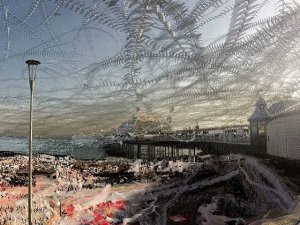Alex May

Alex May
Seagulls Over Brighton Pier (Algorithmic Photograph) (2018)
Digital Print on Hahnemühle Photo Glossy 260gsm
Seagulls over Brighton Pier (2018) is from the Algorithmic Photography project by Alex May that presents the anthropocentric imbalance between humanity and nature through an aesthetic study of motion shaped by human architecture and infrastructure and revealed through the eye of the algorithm.
The project is inspired by the motion study work of Eadweard Muybridge who developed photographic technology to record an event that the human eye could not see (to settle a bet about whether a horse lifts all four feet off the ground while running). We use technology to see further than our own physical abilities allow; from the telescope to the electron scanning microscope to the Mars Rover, but a still image, while recognisable, is not natural to us – we see and make sense of the world in motion, however slight. To look at one frame from Muybridge's running horse series tells us something new that we cannot perceive with our eyes, but it doesn't intrinsically describe the running motion of the horse unless one looks at the entire series. These Algorithmic Photographs use a wide range of digital processing and computer vision techniques to bring motion to photography not through motion blur, which is the established form of representing motion in still photography, but through a compression of time and space, where individual moments are still distinguishable in the joyful and impossible collision of everything.
This photograph is comprised of 7,500 frames of video (5 minutes at 25 frames per second) combined into a single image using an algorithm that selectively chooses what data to preserve from each frame and what to ignore. It uses just one of hundreds of different algorithms that May has developed for this project.
The algorithms have evolved from a wide range of previous works by May including 'Statues Also Die' (2008) that was his first interactive installation to explore slow time, 'Shadows of Light' (2009) where people have to stay still to interact, and My Robot Companion (2011) a humanoid robot that dynamically adjusts its face to fit in with the people around it. These installations interactively explore our relationship with time and encourage visitors to engage with digital work slowly.
The photograph shows seagulls circling overhead watching for opportunities to swoop down and steal food from unwary visitors below. The domains of air, water, and earth are clearly delimited with the beach itself hidden under the constant transit of families and tourists, while the birds have dominion over the sky with all the predatory advantage that presents. The human-made pier invades the sky and the sea to allow people to transit into these domains purely for their entertainment.
